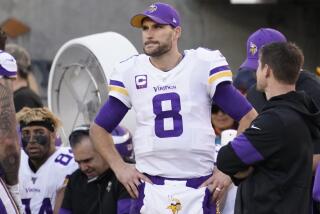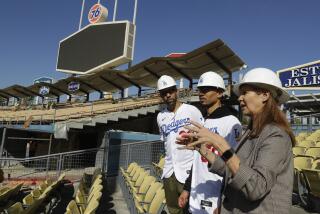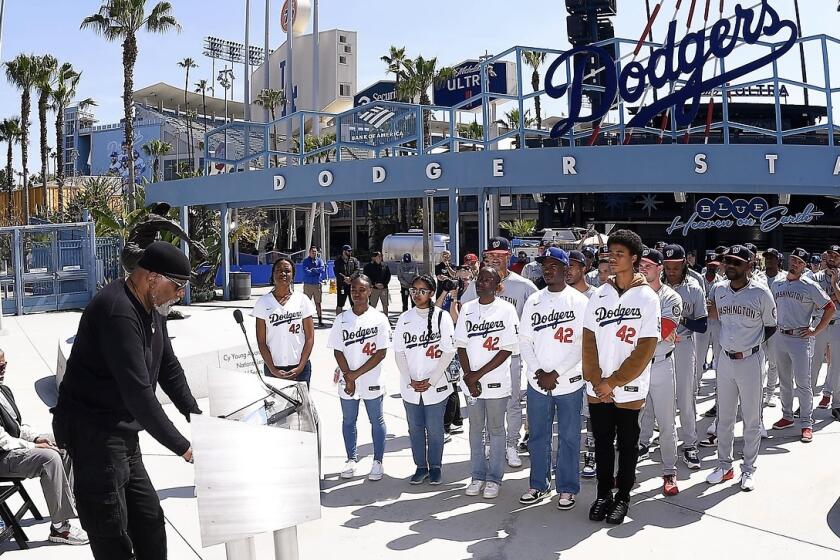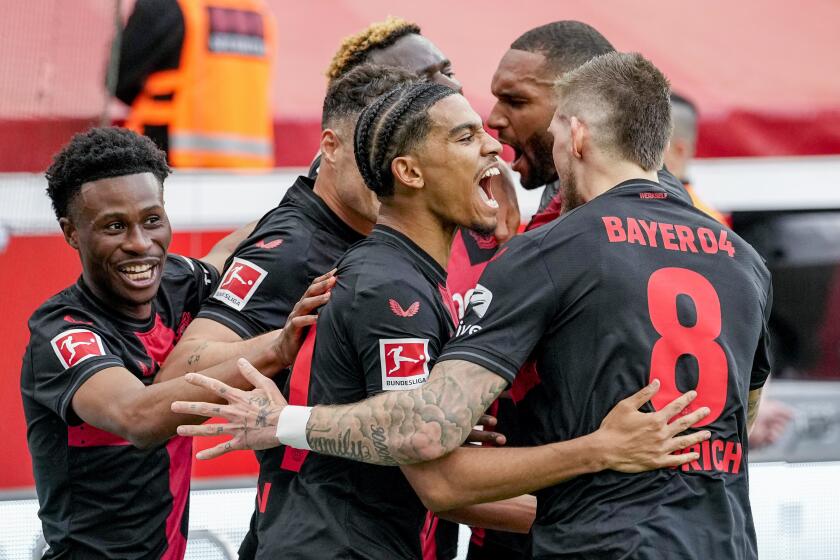Facing their own deadline, owners offer diverging views on how to return NFL to L.A.

Cowboys owner Jerry Jones talks to reporters during a post-game interview after a loss to the Saints.
Dallas Cowboys owner Jerry Jones emerged from NFL headquarters Tuesday with an unmistakable message.
He’s ready to get Los Angeles done.
“My role completely here is not one of selling anybody,” said Jones, standing just off Park Avenue on a pristine day when the league held smaller committee meetings. “My role is to just remind us that we don’t have but one chance to do it right in Los Angeles. Let’s get it right. And let’s do it.”
Make no mistake, there will be all sorts of sales pitches involved. The league’s 32 owners are trying to come to an agreement on how to return to the nation’s second-largest market after a 20-year absence. This game of musical chairs involves three franchises and two sites, with St. Louis Rams owner Stan Kroenke vying for his stadium plan in Inglewood, and San Diego Chargers owner Dean Spanos and Oakland Raiders owner Mark Davis jointly backing a competing project in Carson.
All the owners will convene Wednesday at the Waldorf Astoria hotel, two blocks away from league offices, for their annual fall meetings. L.A. is the primary topic, which is almost unheard of for this time of year. Typically, talks about that market take place in the spring, when there’s more time to ramble on about which direction the league might be heading.
But the clock is winding down on the NFL’s stated goal of making a decision in time to have professional football in the L.A. market by next season. And, although many owners are cryptic about which way they’re leaning, clearly opinions are beginning to solidify.
Jones has lavishly praised the deep-pocketed Kroenke before for his willingness to be bold and take a risk on L.A., much the way Jones took a risk when he bought the Cowboys in 1989, in the aftermath of the Texas oil bust.
“Lamar Hunt stood up in an owners’ meeting — and I was so proud when he said it,” Jones said, referring to the late owner of the Kansas City Chiefs. “He said, ‘The biggest risk I’ve ever seen in sports is Jerry Jones when he bought the Dallas Cowboys.’ … I was intoxicated and blind with passion, and I wanted to be involved in the NFL and I wanted the Cowboys, and I ignored that. That’s to me the passion that moves mountains. That’s the thing that gets it done.
“Los Angeles is the deserving market and has been without the NFL so long, that if we have an opportunity to do something like that out there… ownership that will make that kind of commitment, if we have that, we’ve got to take it.”
But there’s another school of thought among the owners, those who believe Spanos should be rewarded for taking his time to scour his market to find a stadium solution. From the perspective of his fellow owners, he has done that, even though many people in San Diego argue there are still options to be exhausted.
Jerry Richardson, owner of the Carolina Panthers and a member of the six-owner Committee on Los Angeles Opportunities, is believed to be a strong proponent of Spanos and the way he has gone about this process. Bob McNair, owner of the Houston Texans, another member of the L.A. committee, seems to subscribe to that philosophy too, although he has not publicly said which plan he prefers.
McNair said Tuesday a major factor in the decision will be which team or teams have satisfied the relocation guidelines, which is code for turning over every stone.
McNair said meeting the relocation guidelines “is sort of the qualifier,” and “after that we look at it on the basis of what’s in the best interest of the clubs, and what’s in the best interest of the league.”
That would seem to favor an owner who has done everything by the book and checked all the boxes, and that’s the reputation Spanos has among many of his fellow owners.
Get the latest in sports with our free newsletter >>
On the topic of two teams moving to L.A., some owners believe that could happen sequentially, while others think it would have to happen simultaneously so one club would not have a clear marketing advantage over the other.
“I think they’d have to move them at the same time,” McNair said. “I think the team coming later would be at a distinct disadvantage. We want to make sure whatever we do, we have a successful franchise or franchises in Los Angeles. That’s the key.”
Jones, however, thinks the teams could come one after another and still be on equal footing.
Asked whether it’s necessary to move teams at the same time, Jones said: “No — emphatically, no. I don’t mean it shouldn’t be that way, I’m just saying it’s possible to do both and it’s possible to do one and then the other.
“With the size market of Los Angeles, the history, the tradition, the uniqueness of these franchises … you can work around a first being the one, a first being dominant, a first being the groundbreaker. You can work completely around that.”
In short, there remain significant differences of opinion among owners on a wide ranges of L.A.-related topics. And these are owners have been wildly successful in the business world typically by following their instincts, and zigging when others zag. They are independent thinkers. So getting them all on the same page is a daunting challenge.
Jim Irsay, owner of the Indianapolis Colts, thinks that’s entirely possible. He said there’s a “high likelihood” that either one or two teams will be playing in L.A. by next fall.
“There’s a greater percentage chance [than not] that there will be a team or teams there next year,” he said. “A lot will be determined in the next three or four months.”
Irsay didn’t rule out the possibility the league could push the pause button and delay a decision for another year but said there’s a better chance the situation gets resolved.
“I think in the end you have to come to sometimes difficult decisions where you have to take the vote and move on from there,” he said. “Of course [a delay] is always possible, but I think we’re excited about the possibility of this going forward soon. But obviously there has to be temporary facilities and those things planned as well.”
So much to do, so little time.
“Deals get done when there are deadlines,” Irsay said. “We’ll see where it goes.”
Twitter: @LATimesfarmer
MORE ON NFL
San Diego mayor stresses city’s stadium plan to NFL’s L.A. relocation committee
NFL kickers are gaining attention, mostly for the wrong reasons
NFL report: British official pushes for team in London
More to Read
Get our high school sports newsletter
Prep Rally is devoted to the SoCal high school sports experience, bringing you scores, stories and a behind-the-scenes look at what makes prep sports so popular.
You may occasionally receive promotional content from the Los Angeles Times.







